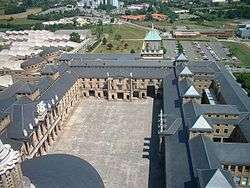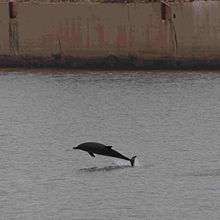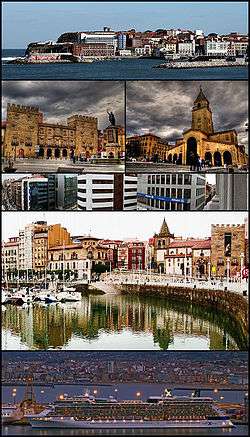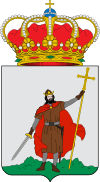Gijón
Gijón
| |||
|---|---|---|---|
| Municipality | |||
| Gijón / Xixón [1] | |||
|
Top:View of Santa Catalina Hills (Cerro de Santa Catalina), 2nd row:Revillagigedo Palace and Don Pelayo Statue (left), San Pedro Church (right), 3rd row:A office area in Munuza Street, 4th row:Cimadevilla area and San Juan Bautista, Bottom:Twilight view of El Musel Port | |||
| |||
 Location of Gijón | |||
 Gijón Location in Spain | |||
| Coordinates: 43°32′N 5°42′W / 43.533°N 5.700°WCoordinates: 43°32′N 5°42′W / 43.533°N 5.700°W | |||
| Country |
| ||
| Autonomous community |
| ||
| Province | Asturias | ||
| Comarca | Gijón | ||
| Judicial district | Gijón | ||
| Founded | 5th century BC (Noega, the first settlement on record) | ||
| Government | |||
| • Mayor | Carmen Moriyón (FAC) | ||
| Area | |||
| • Total | 181.6 km2 (70.1 sq mi) | ||
| Elevation | 3 m (10 ft) | ||
| Highest elevation | 737 m (2,418 ft) | ||
| Lowest elevation | 0 m (0 ft) | ||
| Population (2016) | |||
| • Total | 276,473 | ||
| • Density | 1,500/km2 (3,900/sq mi) | ||
| Demonym(s) |
gijonés, -esa (es) xixonés, -esa (ast) | ||
| Time zone | CET (UTC+1) | ||
| • Summer (DST) | CEST (UTC+2) | ||
| Postal code | 33201–33212 | ||
| Official language(s) | Spanish | ||
| Website | Official website | ||
Gijón (/hɪˈhɒn/, /hiˈhɔːn/ or /xiˈxɔːn/, Spanish: [xiˈxon]), or Xixón (Asturian: [ʃiˈʃoŋ]) is the largest city and municipality in the autonomous community of Asturias in Spain. Early medieval texts mention it as "Gigia". It is located on the Bay of Biscay, approximately 20 km (12 mi) north of Oviedo, the capital of Asturias.
History
Prehistory and Romanization
The first evidences of human presence in what is known nowadays as municipality of Gijón are located in Monte Deva, where exist a serie of tumulus, and in Monte Areo, where there are some neolithic dolmens. These dolmens were discovered in 1990 and is supposed it was built about 5000 BC.
The first noticed settlement (Noega) is located in Campa Torres. It has its origin between the 6th and 5th centuries BC. It was populated by Astures (Cilúrnigos) and later Romanized. Noega was progressively abandoned when the Roman wall in the peninsula of Cimavilla, called the Gegionem, was built.
Middle Ages and Modern Era
Despite the Barbarian invasions left no trace, it seems the territory was submitted to the power of the Visigoth king Sisebut in the 7th century. From this moment it could appear the first Christian worship demos, where one of its places was the Roman villa of Veranes.
Gijón was capital of the Muslim territories in the Cantabric Sea, under the power of Munuza, who dominated the city between 713 and 718 or 722. In this last year, Asturians won the Battle of Covadonga, started in 718 and led by Pelagius, who would become the first King of the Kingdom of Asturias.
Until 1270 there were no reliable references to Gijón as a settlement, with only short mentions in some documents. In this year, Alfonso X of Castile conceded the category of puebla.
In the 14th century, the war between Alfonso Enríquez of Castile and Henry III of Castile finished with the village of Gijón fenced, burned and totally destroyed, practically disappearing.
In the 15th and 16th centuries, Gijón was again developed. A new dock was built in the port adding fishing and commerce to the area.
In the 17th and 18th centuries Gijón started to have great development, growing out of the old city center. This happened when the port of Gijón had commerce with the American colonies. In the 18th century, due to the French invasions, the wars and the financial trouble in the era, the development stopped until late in the century, when the Oviedo-Gijón road was created and the port was recognized as the best one in Asturias, favouring the start of industrial activities in the village.
Contemporary history

The 19th century brought with it great development, with the commerce of coal, the Gijón–León road and later the Langreo–Gijón railway. All this supposed the quick expansion of the port, due to the heavy traffic intensity in it. A new port, El Musel, was built in 1893 and it was the first coal port of the peninsula.
Gijón was going through a conversion to an industrial village with a new bourgeois and an urban development, opening new streets and squares, with new municipal equipments like water, garbage collection, lighting, and so on. All this industrial development brought new manpower to the city and the creation of new neighbourhoods like Natahoyo, La Calzada, Tremañes or El Humedal.
In the 20th century, with the Spanish Civil War, the city supported the Republican faction. The army was located in El Coto. The resistance was eliminated in August 1936. Later, the village was the capital of the Sovereign Council of Asturias and León until 20 October 1937, when the troops of General Francisco Franco occupied the city.
Ferrous metallurgy was the main industry of Gijón from the last years of the 19th century until the last decades of the 20th. Uninsa was created in 1971, and it merged with Ensidesa. In the last years of the century was converted in Aceralia, and integrated in Arcelor.
The last decades of the century brought an industrial crisis affecting mainly the ferrous metallurgy and the local shipbuilding. This facts brought new terrain for the creation of new beaches, parks and new neighbourhoods. It was also created a campus of the University of Oviedo.
Geography
| Population of Gijón | ||
|---|---|---|
| Year | Pop. | ±% p.a. |
| 1857 | 23,621 | — |
| 1860 | 24,802 | +1.64% |
| 1877 | 30,591 | +1.24% |
| 1887 | 35,170 | +1.40% |
| 1897 | 43,392 | +2.12% |
| 1900 | 45,544 | +1.63% |
| 1910 | 55,248 | +1.95% |
| 1920 | 57,573 | +0.41% |
| 1930 | 78,239 | +3.11% |
| 1940 | 101,341 | +2.62% |
| 1950 | 110,985 | +0.91% |
| 1960 | 124,714 | +1.17% |
| 1970 | 187,612 | +4.17% |
| 1981 | 255,969 | +2.86% |
| 1991 | 260,267 | +0.17% |
| 1999 | 265,491 | +0.25% |
| 2000 | 267,980 | +0.94% |
| 2001 | 267,426 | −0.21% |
| 2002 | 269,270 | +0.69% |
| 2003 | 270,211 | +0.35% |
| 2004 | 270,875 | +0.25% |
| 2005 | 271,039 | +0.06% |
| 2006 | 273,931 | +1.07% |
| 2007 | 274,472 | +0.20% |
| 2008 | 274,037 | −0.16% |
| 2009 | 275,699 | +0.61% |
| 2010 | 277,554 | +0.67% |
| 2011 | 277,198 | −0.13% |
| 2012 | 277,559 | +0.13% |
| 2013 | 277,733 | +0.06% |
| 2014 | 275,274 | −0.89% |
| 2015 | 275,735 | +0.17% |
| 2016 | 276,473 | +0.27% |
| From 1999 to present, population as of each January 1st Source: INE | ||
The city is situated on the coast of central Asturias, from sea level to an altitude of 513 metres at Picu Samartín and 672 metres at Peña de los Cuatro Jueces, bordered on the West by Carreño, the East by Villaviciosa, and to the South by Siero and Llanera
The city is situated along the Asturian coast and is distinguished by the peninsula of Cimavilla (the original settlement) which separates the beach of San Lorenzo and adjacent neighbourhoods to the east from the beaches of Poniente and Arbeyal, the shipyards, and the recreational port and the Port of El Musel to the west. It is close to the other main Asturian cities, Oviedo and Avilés.
Districts
Gijón is divided in six districts:[2] Centre, East, South, West, El Llano and Rural. In this last one, all the peri-urban zone and the rural parishes are integrated.
Neighbourhoods and parishes


|
|
Culture

- During the early years of the 19th century the, then very small, town of Gijón was best known for its college or high-school known as the "Real Instituto Asturiano" founded by Jovellanos.[3]
- The City Hall's sports and culture programs for citizens is wide, including the innovative Abierto Hasta el Amanecer (literally Open Till Dawn) nocturnal program, which tries to involve teens in cultural and sporting activities as an alternative to weekend nightlife.
- Gijón has 13 libraries in its Cultural City Centres, which feature a wide network of swimming pools and gyms.
- One of the most important cultural events in the city is the International Film Festival, recognized as one of the best in Spain. There is also a literary festival, Semana Negra.
Museums and art galleries
- Museum of the Asturian People
- Railway museum of Asturias
- Nicanor Piñole museum
- Roman Terms museum of Campo Valdés
- Juan Barjola museum (A museum about a local painter, also interested in avant-garde art)
- Evaristo Valle museum (Local painter museum placed in a mansion at the outskirts)
- International Bagpipe Museum contains bagpipes from around the world, focusing on the Asturian musical heritage and bagpipes.
- Atlantic botanical garden
- Archaeological park Campa Torres.
- Revillagigedo Palace and museum (At Marqués square, near the City Hall)
- Gijón Aquarium
- Roman Town of Veranes
- LABoral Centro de Arte y Creación Industrial (An exhibition centre for contemporary art, science, technology and advanced visual industries)
Universities
There are two campuses located in Gijón, one of the University of Oviedo and other of the National University of Distance Education.
University of Oviedo
Mechanical Engineering, Electrical Engineering, Electronic Engineering, Computers and Systems Engineering, Chemical Engineering and Telecommunication Engineering.
- School of Civil Navy.
- Faculty of Commerce, Tourism and Social Sciences "Jovellanos".
Public Administration and Management, Trade and Marketing, Tourism and Social work.
National University of Distance Education (UNED)
Gijón also has a delegation of the UNED, where different disciplines can be studied by distance.
Sports


In team sports, Gijón's professional football team, Sporting de Gijón, plays in the Spanish La Liga, with AB Gijón Jovellanos competing in Liga ASOBAL, one of the most important leagues of team handball in the world. In women's sport, Gijón Hockey Club is one of the most important rink hockey teams in Europe.
CSI Gijón is Spain's official show jumping horse show which is held annually in Gijón's equestrian facility.
There is also a private sports club in Gijón with more than 33,000 members, Real Grupo de Cultura Covadonga, the biggest club in Asturias.
Not far from Gijón, there are several ski resorts in Asturias, the main being Valgrande-Pajares.
The city's marina houses an important fleet of yachts and is the base for many water sports, being Royal Astur Yacht Club the most important yacht club in town.
Sports centres
The biggest sport centres in Gijón are Estadio El Molinón, with 30,000 seats, Plaza de Toros de El Bibio with 12,000 and Palacio de Deportes with 5,000 seats. Games were played in town during the 1982 FIFA World Cup.
The city has in total 13 public sport centres (in Spanish: Centros Municipales Integrados) with swimming pools, gyms and saunas. Swimming pools are free for children up to age 14.
Economy
For much of the 20th century the town was heavily dependent on mature heavy industries, but at the end of the Franco era, tertiary sector employment began to expand rapidly along with the city's population which by 2007 stood officially at 277,897 for Gijón proper, and approximately 380,000 for the total Gijón agglomeration.
The port is at the centre of many of the local businesses. Apart from directly port related activities, the economy is based on tourism, steel (Arcelor), other metallurgy, livestock rearing and fisheries.
Climate
Gijón has a temperate oceanic climate[4] typical of the Atlantic coast of Spain, with cool summers and wet and mostly mild winters. The onshore flow from the Atlantic Ocean creates a cool summer and mild winter climate where severe heat and very cold temperatures are rare. The narrow temperature range is demonstrated by the record August temperature being only 6.4 °C warmer than the all-time record January temperature.[5] The climate is wet and cloudy by Spanish standards, but is indeed drier than other locations on the Atlantic in the country. Humidity is high year-round.
Summer temperatures are very consistent as proven by the fact that the all-time warmest month of August 1997 had an average temperature of 20.9 °C (69.6 °F) and no month has ever been recorded at an average high above 24.7 °C (76.5 °F) in comparison to the 23.2 °C (73.8 °F) August normal high.[6] Another clear underlining of the marine influence is that the coolest ever August has been as near the average as 17.9 °C (64.2 °F).[7]
| Climate data for Gijón (1971–2000) | |||||||||||||
|---|---|---|---|---|---|---|---|---|---|---|---|---|---|
| Month | Jan | Feb | Mar | Apr | May | Jun | Jul | Aug | Sep | Oct | Nov | Dec | Year |
| Record high °C (°F) | 23.6 (74.5) |
23.0 (73.4) |
27.0 (80.6) |
28.0 (82.4) |
31.8 (89.2) |
36.4 (97.5) |
31.4 (88.5) |
30.0 (86) |
34.6 (94.3) |
30.4 (86.7) |
26.1 (79) |
25.0 (77) |
36.4 (97.5) |
| Average high °C (°F) | 13.1 (55.6) |
13.8 (56.8) |
14.9 (58.8) |
15.6 (60.1) |
17.8 (64) |
20.2 (68.4) |
22.4 (72.3) |
23.2 (73.8) |
21.8 (71.2) |
19.0 (66.2) |
15.6 (60.1) |
14.0 (57.2) |
17.6 (63.7) |
| Daily mean °C (°F) | 8.9 (48) |
9.6 (49.3) |
10.7 (51.3) |
11.8 (53.2) |
14.3 (57.7) |
16.9 (62.4) |
19.2 (66.6) |
19.7 (67.5) |
17.9 (64.2) |
15.0 (59) |
11.6 (52.9) |
9.9 (49.8) |
13.8 (56.8) |
| Average low °C (°F) | 4.7 (40.5) |
5.4 (41.7) |
6.6 (43.9) |
8.1 (46.6) |
10.9 (51.6) |
13.6 (56.5) |
16.0 (60.8) |
16.2 (61.2) |
14.1 (57.4) |
11.0 (51.8) |
7.6 (45.7) |
5.8 (42.4) |
10.0 (50) |
| Record low °C (°F) | −4.6 (23.7) |
−4.0 (24.8) |
−2.0 (28.4) |
0.4 (32.7) |
3.2 (37.8) |
5.8 (42.4) |
8.6 (47.5) |
8.2 (46.8) |
5.0 (41) |
2.6 (36.7) |
−1.4 (29.5) |
−4.8 (23.4) |
−4.8 (23.4) |
| Average precipitation mm (inches) | 94 (3.7) |
85 (3.35) |
74 (2.91) |
93 (3.66) |
79 (3.11) |
47 (1.85) |
45 (1.77) |
54 (2.13) |
70 (2.76) |
104 (4.09) |
120 (4.72) |
104 (4.09) |
971 (38.23) |
| Average precipitation days (≥ 1 mm) | 12 | 11 | 10 | 12 | 11 | 7 | 6 | 7 | 8 | 11 | 12 | 12 | 121 |
| Mean monthly sunshine hours | 103 | 109 | 137 | 151 | 167 | 180 | 194 | 190 | 158 | 132 | 106 | 92 | 1,721 |
| Source: Agencia Estatal de Meteorología[8] | |||||||||||||
Pollution
Gijón was marked and singled out as one of the pollution hotspots in Western Europe in a 2015 report from the International Institute for Applied Science Systems, where predicitions for 2030 conditions were made.[9][10] The Gijón and Oviedo region was marked much higher than any other Spanish metro area, this in spite of the much larger population in Madrid and Barcelona for example. This was attributed to heavy industrial activities. Since outdoor air pollution is a major cause of premature death in Europe,[11] the excessive pollution is a major concern for Asturias. A Spanish government study conducted in 2010 regarding life expectancy in relative communities Asturias was ranked lowest (tied with Andalucia) for male life expectancy with 76.7 years from 2007 readings.[12] However, female life expectancy was 84 years and normal among autonomous communities. However, even the male life expectancy is only just below Western European standards, and exaggerated by the high Spanish life expectancy rate. Considering a vast majority of the Asturian population lives in proximity to the Gijón heavy industrial activities, these figures for especially female relative health still contributes to a position that Gijón is still a safe location to live. The numbers for "disability-free" life expectancy has risen significantly both for males and females in the area since 1986 according to the report.[13]
Transport
Airports
Gijón is served by Asturias Airport, about 38 km (24 mi) from the centre of the city; it is located in the municipality of Castrillon. The airport is connected to the city by the A-8 motorway, the N-632 national highway and scheduled bus service (Alsa). It has regular flights to the following destinations: Barcelona, Brussels, Fuerteventura, Geneva, Gran Canaria, Ibiza, Lanzarote, Lisbon, London - (Heathrow, Stansted and Gatwick), Madrid, Málaga, Palma de Mallorca, Paris – Charles de Gaulle, Seville, Tenerife-South and Valencia. Operating companies are: Air Berlin, Air France, Air Europa, Iberia or Iberworld.
Seaport
The service offered by LD Lines has been cancelled in Gijón. The closest Ferry services are now in Santander and Bilbao
Actually Gijón still having a good Freight service by El Musel
Public transport
Gijón currently has 21 bus lines, which are:
- Line 1 BRT: Cerillero – Cabueñes Hospital
- Line 2: El Corte Inglés – Cabueñes Hospital
- Line 4: El Lauredal – Viesques – University campus
- Line 6: Musel – Alcampo – Polígono de Porceyo – Polígono de Zarracina
- Line 10: Pumarín – Candenal- Cabueñes Hospital
- Line 12: Cerillero – Montevil – Contrueces
- Line 14: Polígono de Somonte – Tremañes – Infanzón
- Line 15: Nuevo Roces – Viesques – Cabueñes Hospital
- Line 16: Estación Ferrocaril – Vega
- Line 18: Nuevo Gijón – Cabueñes Hospital
- Line 20: Montevil – Somió
- Line 21: Jove Hospital – La Campa Torres
- Line 24: Monteana – La Pedrera – Mareo
- Line 25: Tremañes – Infanzón – La Olla
- Line 26: Gijón – Deva
- Line 28: Plaza del Humedal – El Molinón
- Line 30: Plaza del Humedal – FIDMA (International trade fair of Asturias)
- Line 34: Fomento – Musel (Night Service)
Night bus service (Fridays and Saturdays only, every day 1 July to 31 August)
- Line 41: El Cerillero – Plaza del Carmen (BUHO 1)
- Line 42: Nuevo Roces – Pumarín – Plaza del Carmen (BUHO 2)
- Line 43: Contrueces – Llano – Coto – Plaza del Carmen (BUHO 3)
- Line 44: Vega – Viesques – Arena – Plaza del Carmen (BUHO 4)
Railway
The city is served by the Gijón Railway Station.
Roads and highways
| Type | Name | Alternate name | Itinerary |
|---|---|---|---|
| Highway | | Autovía del Cantábrico | Baamonde – Gijón – Llanes – Torrelavega – Solares – Bilbao – San Sebastián |
| | Autovía Ruta de la Plata | Gijón – Oviedo – Mieres – León – Benavente – Zamora – Salamanca – Béjar – Plasencia – Mérida – Almendralejo – Sevilla | |
| AS-I | Autovía Minera | Gijón – Pola de Siero – Langreo – Mieres | |
| AS-II | Autovía Industrial | Gijón – Lugo de Llanera – Oviedo | |
| GJ-10 | Interior ring road | Gijón seaport (El Musel) – Pumarín – El Llano | |
| GJ-20 | Western ring road | GJ-81 (Autopista Acceso Sur a Gijón) – Tremañes – Gijón seaport (El Musel) | |
| GJ-8 | South access road | (A-8/A-66) – Plaza del Humedal | |
| National road | N-630 | Gijón – Oviedo – Mieres – Puerto de Pajares – León – Zamora – Salamanca – Plasencia – Mérida – Almendralejo – Sevilla | |
| N-632 | Cenero – Cudillero – Muros del Nalón – Soto del Barco – Avilés – Gijón – Villaviciosa – Colunga – Caravia – Ribadesella | ||
| N-641 | El Musel access Road | Gijón – La Calzada – Gijón seaport (El Musel) . | |
| Regional and local roads | AS-19 | Gijón-Avilés Road | Gijón – El Empalme – Prendes – Tabaza – Avilés |
| AS-246 | Carbonera Road | Gijón – Alto de la Madera – Noreña – El Berrón – La Gargantada – Langreo | |
| AS-247 | Piles to Infanzón Road | Gijón – Somió – Alto del Infanzón | |
| AS-248 | Gijón-Siero Road | Gijón – Vega de Poja – Pola de Siero | |
| AS-266 | Oviedo-Gijón Road | Oviedo – Lugones – Pruvia – Porceyo – Gijón | |
| AS-19a | Gijón-Avilés Road | Puenteseco – Muniello | |
Government
Since the Spanish transition to democracy, PSOE governed continuously during 32 years, from 1979 to 2011.
Since 11 June 2011, the city mayor is Carmen Moriyón of Asturias Forum, who was supported with the votes of the Popular Party.
Councillors distribution in local elections
| Political party | 1979 | 1983 | 1987 | 1991 | 1995 | 1999 | 2003 | 2007 | 2011 | 2015 |
|---|---|---|---|---|---|---|---|---|---|---|
| PSOE | 13 | 17 | 11 | 12 | 12 | 16 | 13 | 13 | 10 | 7 |
| FAC | 9 | 8 | ||||||||
| Xixón Sí Puede | 6 | |||||||||
| AP / PP | 1 | 7 | 7 | 9 | 11 | 9 | 11 | 12 | 5 | 3 |
| IU | 4 | 3 | 3 | 3 | 4 | 2 | 3 | 2 | 3 | 2 |
| UCD / CDS | 9 | 6 | ||||||||
| UGJ | 3 | |||||||||
| C's | 1 | |||||||||
Mayors
| Name | Start | End | Party |
|---|---|---|---|
| José Manuel Palacio | 1979 | 1987 | PSOE |
| Vicente Álvarez Areces | 1987 | 1999 | PSOE |
| Paz Fernández Felgueroso | 1999 | 2011 | PSOE |
| Carmen Moriyón | 2011 | FAC | |
International relations
Twin towns/Sister cities
Gijón is twinned with:
|
|
References
- ↑ Decree 105/2006, of September 20th, which establishes the official toponyms of Gijón municipality.
- ↑ Consejos de Distrito Gijón City Hall website
- ↑ (English) Name of the "Instituto Asturiano" and other details taken from the Universal Pronouncing Gazetteer By Thomas Baldwin, Sixth Edition, (1847).
- ↑ "Gijon, Spain Climate Summary". Weatherbase. Retrieved 22 July 2015.
- ↑ "Extreme values for Gijón". Aemet.es. Retrieved 22 July 2015.
- ↑ "Extreme Values: Gijón". Aemet.es. Retrieved 22 July 2015.
- ↑ "Extreme values: Gijón". Aemet.es. Retrieved 22 July 2015.
- ↑ "Valores Climatológicos Normales. Gijon".
- ↑ "Map: These will be the Europe's most polluted cities in 2030". Washington Post. Retrieved 2 March 2015.
- ↑ "Modelling Street Level PM10 Concentrations Across Europe" (PDF). International Institute for Applied Science Systems. Retrieved 2 March 2015.
- ↑ "Air – Environment". European Commission. Retrieved 2 March 2015.
- ↑ "Healthy life expectancies in Spain 1986-2007" (PDF). Government of Spain: Ministry of Health, Social Policy and Equality. Retrieved 23 May 2015.
- ↑ "Air – Environment". European Commission. Retrieved 2 March 2015.
External links
| Wikivoyage has a travel guide for Gijón. |
| Wikimedia Commons has media related to Gijón. |
- Gijón Municipality
- Official Touristic website of Gijón
- Official Toponyms – At City Council official website.
- Official Toponyms: Laws – BOPA No. 229 – Martes, 3 de octubre de 2006 & DECRETO 105/2006, de 20 de septiembre (BOPA Errata corrections)
- Official site Sporting de Gijón
- LABoral Centro de Arte y Creación Industrial


